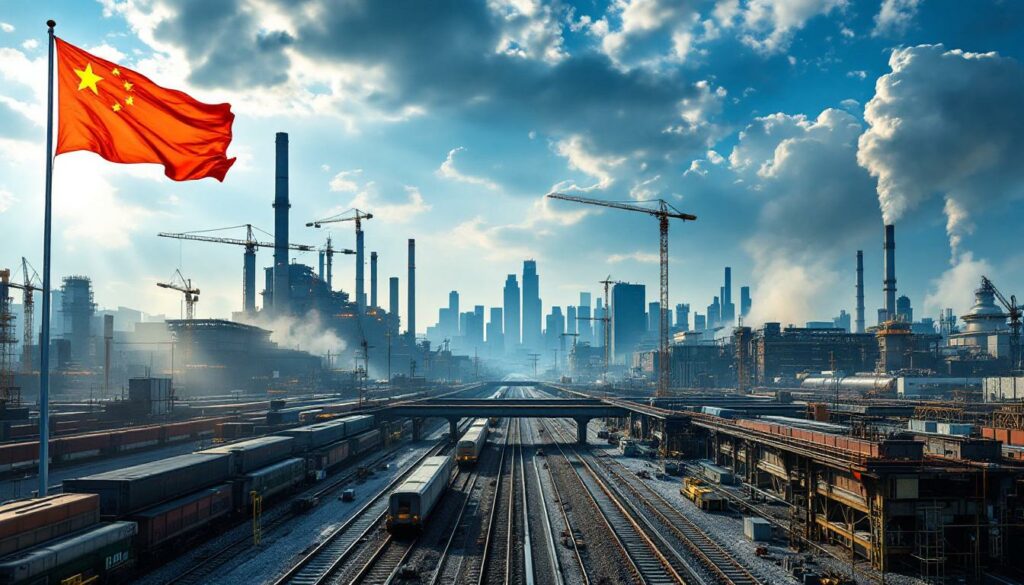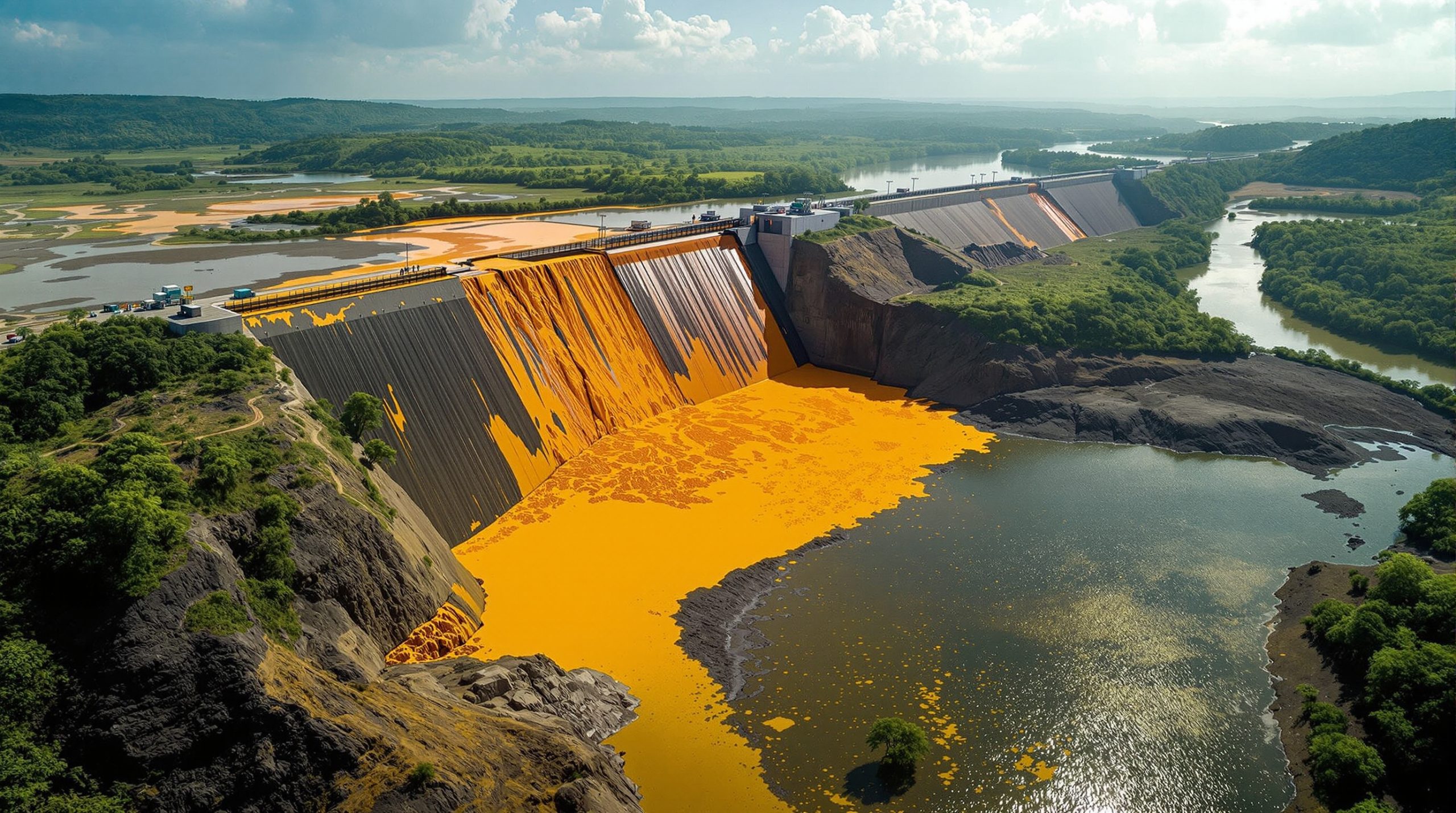Understanding China's Steel Industry: Demand Challenges and Reform Progress
China's steel industry faces significant structural challenges as it navigates through a period of transition. While the sector has long been a pillar of China's economic growth, recent years have witnessed mounting pressures from declining domestic demand, environmental concerns, and international trade tensions. Despite these challenges, structural reforms are showing promising signs of addressing longstanding issues of overcapacity and sustainability.
What Are the Fundamental Issues Facing China's Steel Sector?
The Core Demand Problem
China's steel sector is grappling with a fundamental demand issue, primarily driven by a weakening property market. According to the World Steel Association's "Steel Statistical Yearbook 2025," steel consumption declined by 3.5% year-over-year in 2024 amid a significant construction slowdown.
"China's steel sector fundamentally has a demand issue driven by weakening property markets," notes Vivek Dhar, mining and energy economist at Commonwealth Bank of Australia (CBA), in a recent interview with CNBC's "The China Connection."
The property sector, traditionally the largest consumer of steel in China, has entered a protracted slowdown. Investment in real estate development fell by 7.2% in the first half of 2025, according to the National Bureau of Statistics of China. This decline represents a structural shift rather than a cyclical downturn, as the government continues to emphasize "housing is for living, not for speculation."
Manufacturing growth has been insufficient to offset construction-related losses. The China Metallurgical Industry Planning Institute reports that manufacturing contributed only 48% of total steel demand growth in 2024, creating a significant demand gap that continues to challenge the industry.
The domestic consumption pattern reveals a structural imbalance, with construction accounting for approximately 55% of steel usage compared to just 20% in advanced economies (OECD, "Global Steel Usage Patterns," 2025). This overreliance on construction has left the steel industry vulnerable to property market fluctuations.
Overcapacity Concerns
The mismatch between production capacity and actual demand remains a persistent challenge. Current capacity utilization hovers around 68%, well below the 80% threshold considered healthy by industry standards, according to the China Iron & Steel Association (CISA).
This overcapacity issue stems from years of rapid expansion driven by local governments' GDP growth targets and employment considerations. Many provinces have built their economic development models around steel production, creating strong regional dependencies that complicate reform efforts.
The Evergrande Group's bankruptcy in 2024 eliminated an estimated 12.7 million tons of annual steel demand (S&P Global, "Corporate Impact on Commodity Markets," December 2024), highlighting how property sector troubles directly impact steel consumption.
Environmental concerns further complicate the overcapacity issue. The steel industry accounts for approximately 15% of China's carbon emissions, making it a key target in the country's climate action plans. Excess production not only creates economic inefficiencies but also works against China's carbon neutrality goals.
How Are China's Steel Sector Reforms Progressing?
Nationwide Reform Implementation
Despite the challenges, China's steel sector reforms are showing encouraging signs of progress. According to Vivek Dhar of CBA, "Nationwide buy-in for curbing overcapacity is a good sign; structural reforms are working."
The Ministry of Industry and Information Technology has set an ambitious nationwide capacity reduction target of 30 million tons for 2025, signaling continued commitment to addressing the overcapacity issue.
Coordination between central and local governments has improved significantly, with provincial authorities increasingly aligning their economic development plans with national industrial policy objectives. This represents a departure from past practices where local governments often circumvented central directives to protect local industries and employment.
Hebei province, China's largest steel-producing region, has demonstrated that effective reform implementation is possible. The province cut capacity by 12 million tons in 2024 while maintaining a 94% employment retention rate, according to the World Bank's "Just Transition Case Studies" (2025). This success story provides a blueprint for other regions facing similar transitions.
Regional economic diversification efforts are creating alternative employment opportunities in steel-dependent areas. Industrial parks focusing on advanced manufacturing, renewable energy, and service industries are being established in traditional steel hubs, helping to mitigate the social impact of capacity reductions.
Production Control Mechanisms
China has implemented a sophisticated set of production control mechanisms that go beyond simple capacity caps. These include:
-
Environmental compliance requirements: Steel mills failing to meet emissions standards face production restrictions or closure. Environmental compliance costs rose 22% year-over-year in 2024, forcing 14% of mills to upgrade their facilities (CISA, "Annual Sustainability Report").
-
Air quality-linked production cuts: Production restrictions are tied to air pollution thresholds, with PM2.5 readings above 45μg/m³ triggering automatic 50% output cuts in affected regions.
-
Differentiated electricity pricing: High-emission mills face electricity tariff penalties of up to 20%, creating financial incentives for cleaner production.
-
Quality-focused initiatives: Production permits now favor mills producing higher-grade, specialty steel products rather than commodity-grade materials, supporting the shift from quantity to quality.
These mechanisms are reshaping industry practices, with mills increasingly investing in efficiency improvements and environmental controls rather than capacity expansion. The focus has shifted from volume-based growth to value-added production and sustainability.
What Impact Do China's Steel Reforms Have on Global Markets?
International Trade Dynamics
China's steel sector reforms are significantly reshaping global trade patterns. Despite ongoing reforms and anti-dumping investigations, China's steel exports rose 8.3% month-over-month in June 2025, according to the General Administration of Customs of China.
This resilience in exports reflects what Vivek Dhar describes as "workarounds for anti-dumping investigations, including third-country processing and value-added product shifts."
Vietnam, historically a major destination for Chinese steel, launched 23 anti-dumping cases against Chinese steel products in 2024 alone (WTO Trade Monitoring Database). Similar measures have been implemented by India, Malaysia, and other regional competitors, creating significant trade tensions.
Chinese producers have responded with strategic adaptations. "Processing zone relocation" has emerged as a common practice, where semi-finished steel is exported to Vietnam or other countries for final processing, effectively bypassing anti-dumping duties targeted at finished products.
The composition of China's steel exports has shifted dramatically toward higher-value products. Silicon steel, automotive steel, and other specialty products now comprise 34% of shipments compared to just 19% in 2020 (BMI Research), reducing the vulnerability to anti-dumping measures typically focused on commodity products.
Trade Adaptation Case Study: Baowu Steel, China's largest producer, established a joint venture with Indonesian partners that effectively avoids the 25% EU tariffs applied to Chinese-origin steel (Reuters, "Steel Trade Routes," May 2025). This represents a sophisticated response to trade barriers that maintains market access while technically complying with regulations.
Global Supply Chain Implications
The evolution of China's steel industry is forcing adjustments throughout global supply chains. Iron ore suppliers, particularly those in Australia and Brazil, are recalibrating production plans based on revised China iron ore trends.
Price volatility has increased significantly, with correlation between Chinese hot-rolled coil prices and Turkish/EU equivalents reaching r=0.89, indicating the continued influence of Chinese markets despite reform efforts.
Shipping and logistics sectors are adapting to changing trade patterns. Dry bulk carriers have adjusted routes to accommodate the shift in export destinations from traditional markets like Southeast Asia to emerging markets in Africa and Latin America.
Alternative steel producers in countries like India, Vietnam, and Turkey are seizing competitive opportunities created by China's capacity reductions. India's steel production grew by 9.3% in 2024, with exports increasing by 15.2% as it moved to fill gaps in markets traditionally served by Chinese producers.
How Is Infrastructure Development Affecting Steel Demand?
The Yarlung Tsangpo Mega Dam Project
The market reaction to China's announcement of the Yarlung Tsangpo mega dam project illustrates the tendency to overestimate the steel demand impact of individual infrastructure projects. According to Vivek Dhar, "Markets overreacted to the Yarlung Tsangpo project; its steel demand is marginal in the national context."
A realistic assessment from the China Gezhouba Group Corporation (CGGC) Project Blueprint (2025) indicates that the dam will require approximately 1.2 million tons of steel spread over a 15-year construction period—representing just 0.1% of China's annual steel production.
The timeline for steel consumption is heavily back-loaded, with 60% of steel requirements concentrated in years 7-10 (post-2030). This extended timeline significantly dilutes the immediate demand impact.
For context, the Three Gorges Dam—previously China's largest hydroelectric project—used approximately 600,000 tons of steel annually during peak construction phases (CISA Historical Archive). The Yarlung Tsangpo project, despite its scale, will not reach these levels of steel intensity due to advances in construction technology and materials efficiency.
Broader Infrastructure Investment Landscape
China's approach to infrastructure development has evolved significantly, with implications for steel demand patterns. National infrastructure investment grew by only 4.1% in 2025 compared to a 9.3% average during 2010-2020 (National Bureau of Statistics, "Fixed Asset Investment Report").
This slowdown reflects a shift from quantity to quality in project selection. Government policy now emphasizes:
- Strategic value over scale: Projects are evaluated based on economic return potential rather than sheer size
- Technological sophistication: Modern infrastructure incorporates more digital components and fewer raw materials
- Environmental sustainability: Green infrastructure projects receive priority funding and approval
The steel intensity of infrastructure has also changed. Modern transportation projects utilize high-strength steel (tensile strength >700MPa), which reduces the total volume required while maintaining structural integrity. Similarly, renewable energy infrastructure requires different steel specifications than traditional power plants, altering consumption patterns.
Regional development initiatives like the Western China Development Program continue to drive localized demand, but with greater emphasis on sustainability and efficiency. Steel-to-concrete ratios in modern infrastructure projects have declined by approximately 15% compared to projects from the previous decade.
What Are the Environmental Dimensions of China's Steel Reforms?
Decarbonization Efforts
Environmental considerations have become central to China's steel industry reforms. The sector accounts for approximately 15% of the country's carbon emissions, making it critical to China's pledge to reach carbon neutrality by 2060.
Emissions reduction targets are driving significant changes in production methods. Mills are increasingly adopting cleaner technologies, with scrap-based production rising to 22% in 2024 (China Metal Recycling Association, "Scrap Utilization Report"). The national target is to reach 30% by 2030, which would significantly reduce the carbon footprint of steel production.
Carbon pricing mechanisms are reshaping competitive dynamics within the industry. The cost of carbon under China's national emissions trading scheme stood at $6.50 per ton of CO2 in 2024 and is projected to reach $15 by 2030 (Shanghai Environment Exchange). This increasing cost is incentivizing investments in efficiency and cleaner production.
Technological innovation is accelerating in response to these pressures. Dr. Li Zheng of Tsinghua University notes that "Hydrogen reduction pilots could cut blast furnace emissions by 50%, but scalability remains challenging" (Nature Materials, "Decarbonizing Steel," June 2025). These hydrogen-based processes require approximately 48 kWh per kilogram of hydrogen and iron ore purity exceeding 67%.
Carbon capture implementation, while still in early stages, shows promise. Retrofits can capture up to 90% of CO2 emissions but increase energy use by 25% (IEA Iron & Steel Technology Roadmap). The economics of these technologies improve as carbon prices rise.
Circular Economy Integration
The steel industry is increasingly embracing circular economy principles. Scrap utilization has become a central strategy, with collection infrastructure expanding into rural areas previously overlooked by recycling efforts.
Product design changes are facilitating end-of-life material recovery. Standardization of steel components in construction and manufacturing simplifies future recycling, while design-for-disassembly approaches are becoming more common in automotive and appliance sectors.
Value chain collaboration is enhancing resource efficiency. Steel producers are forming partnerships with automotive manufacturers, construction companies, and other major consumers to develop closed-loop material systems that maximize recycling potential.
The environmental benefits extend beyond carbon reduction. Water consumption per ton of steel produced has decreased by 23% since 2015 (CISA Sustainability Report), while particulate emissions have fallen by over 40% due to improved filtration technologies.
How Should Investors Interpret China's Steel Sector Trends?
Key Performance Indicators
Investors monitoring China's steel sector should focus on several key performance indicators that signal the health and direction of the industry:
- Production-to-consumption ratios: Currently at 1.09 (down from 1.17 in 2020), indicating improving balance between supply and demand
- Capacity utilization rates: Increasing from 68% toward the 80% benchmark would indicate successful reform implementation
- Price-to-cost relationships: Current industry profit margins stand at 2.8% in 2024 compared to 11.5% in 2018 (Wind Financial Database)
- Export volume patterns: Monthly fluctuations provide early signals of domestic market conditions
Reform-compliant mills are demonstrating superior financial performance, with an average return on equity of 8.5% compared to 3.2% for those facing compliance issues. This divergence highlights the emerging competitive advantage of early adapters to the new regulatory environment.
The production concentration ratio (CR10) has increased from 37% in 2020 to 45% in 2024, indicating consolidation is occurring in line with policy objectives. Further increases would suggest continued successful implementation of reforms.
Strategic Outlook Considerations
Investors should consider several strategic factors when evaluating the long-term outlook for China's steel sector:
- Long-term structural transformation: The transition from property-led demand to manufacturing and infrastructure will continue for at least 5-7 years
- Regional variation in reform implementation: Coastal provinces are progressing faster than inland regions, creating investment opportunities in leaders
- Policy consistency assessment: Current leadership has maintained reform direction despite economic headwinds, suggesting strong commitment
- Alternative growth pathways: High-value specialty steel production is emerging as the sustainable growth segment
The steel industry's transformation aligns with China's broader economic rebalancing toward higher-quality, sustainable growth. Mills successfully navigating this transition through technological upgrades, environmental compliance, and product diversification will likely emerge as long-term winners.
What Are the Commodity Market Implications?
Iron Ore Market Dynamics
China's steel sector reforms are profoundly impacting global iron ore markets. Despite capacity controls, China still accounts for over 70% of seaborne iron ore demand, making shifts in Chinese steel production highly consequential for suppliers.
Quality premiums have evolved significantly, with high-grade ore (>65% Fe) commanding premiums of $18-25 per ton over the 62% benchmark, nearly double the historical average. This reflects both environmental regulations favoring cleaner inputs and the technical requirements of more efficient production processes.
Contract structures are adapting to new market realities. Traditional benchmark pricing mechanisms are giving way to more complex arrangements that incorporate quality adjustments, impurity penalties, and sustainability metrics.
Major suppliers are recalibrating investment plans. Rio Tinto, BHP, and Vale have collectively reduced capacity expansion projects by approximately 45 million tons (annualized) compared to pre-2020 plans, reflecting more conservative long-term demand projections for China.
The iron ore surplus analysis shows that market dynamics are shifting as China's steel sector reforms progress, creating both challenges and opportunities for industry participants.
Coking Coal and Other Input Materials
The coking coal market faces similar adjustments as iron ore. Price relationships between metallurgical coal grades have shifted, with premium hard coking coal commanding higher differentials over semi-soft coking coal due to its superior environmental performance.
Regional sourcing strategies have adapted to geopolitical tensions. Chinese imports of Australian coking coal resumed in 2023 after an informal ban, but volumes remain below historical levels as mills diversified suppliers to include more Russian, Mongolian, and Canadian sources.
Substitute materials are gaining traction as mills explore alternatives to traditional inputs. Hydrogen-based reduction, while still in pilot phases, threatens long-term coking coal demand. Similarly, natural gas-based direct reduced iron (DRI) processes are increasing in regions with abundant gas supplies.
Alloying materials face shifting demand patterns as steel product mixes evolve. Specialty steels requiring specific alloys like vanadium, molybdenum, and niobium are growing in importance, creating new demand dynamics in previously niche markets.
FAQs About China's Steel Industry Reforms
What is driving China's steel sector reforms?
China's steel sector reforms are driven by a convergence of environmental, economic, and international factors:
- Environmental sustainability requirements: The steel industry must align with China's pledge to reach peak carbon emissions before 2030 and carbon neutrality by 2060
- Economic efficiency imperatives: Overcapacity creates financial strain and inefficient resource allocation throughout the economy
- International trade relationship management: Export restraint helps reduce US‑China trade war impacts
- Domestic industrial policy evolution: The shift toward higher-quality growth necessitates industrial upgrading across sectors
The combined pressure from these factors has created unprecedented momentum for meaningful reform, over
Are You Looking for the Next Major Mineral Discovery on the ASX?
Discovery Alert's proprietary Discovery IQ model delivers real-time notifications when significant mineral discoveries are announced on the ASX, giving you an immediate edge in the market. Explore our dedicated discoveries page to understand how historic discoveries have generated substantial returns and begin your 30-day free trial today.




